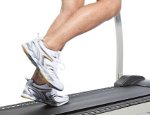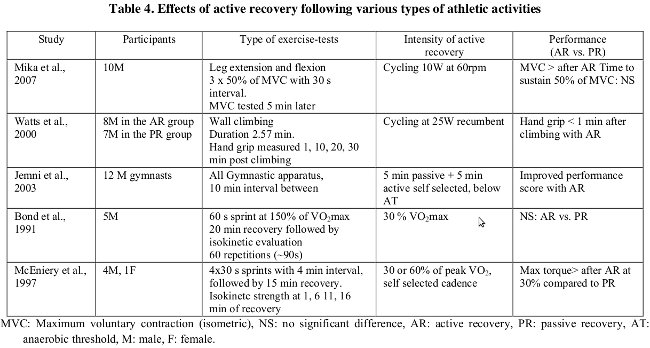 Active recovery during various types of exercise
Active recovery during various types of exercise
Despite performance time, mean power, peak power and total work measured in most of the studies, there are other specific sport abilities that should be examined after active recovery compared to passive recovery. The evaluation of isometric muscle force and muscle torque during isokinetic contractions are important parameters for specific sports performance. Several studies examined the force and isokinetic muscle function after active or passive recovery. Following a 60 s maximum exercise at 150% of VO max, active recovery (cycling at 30 % of VO2max) or passive recovery had no positive or negative effect onpeak torque and total work of the dominant quatriceps during 60 repetitions (~90 s) performed at an angular velocity 150o·s-1 (Bond et al., 1991). In contrast, the maximum torque measured at an angular velocity of 60o·s-1 was increased after 15 minutes of active recovery at 30% but not after active recovery at 60% of the VO2max(McEniery et al., 1997).
The maximum voluntary contraction (MVC:isometric force) was measured after low intensity (50% of MVC) isometric contraction to fatigue and improved after a 5-min active recovery cycling at 10W (60 rpm) compared to passive recovery (Mika et al., 2007). Furthermore, the isometric hand-grip force, which may be important for climbing, was reduced during the 30 minutes after a climbing trial (Watts et al., 2000). The reduction in isometric hand-grip force was significantly greater one minute after the trial when the climbers applied recumbent cycling at 25W as active recovery compared to passive recovery (Watts et al., 2000).
Partially active recovery (5 min active plus 5 min passive) was applied during the 10-min interval separating the six competitive men’s gymnastics events (floor, pommel, rings, vault, parallel bars, horizontal bar), and this practice helped the participants to achieve higher scores compared to passive recovery (Jemni et al., 2003). The different protocols applied and the limited number of studies where the isometric muscle force or muscle torque was examined do not allow us to reach a firm conclusion concerning the
effectiveness of active recovery on muscle function. Further research is needed to examine the efficacy of active recovery under specific sport conditions. A summary of the findings concerning muscle function and specific sport activities ispresented in Table 4.
MVC: Maximum voluntary contraction (isometric), NS: no significant difference, AR: active recovery, PR: passive recovery, AT:
anaerobic threshold, M: male, F: female.

